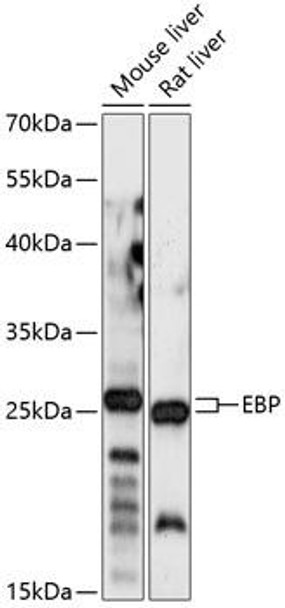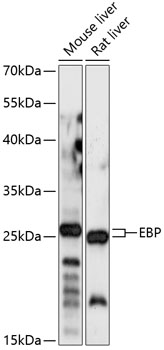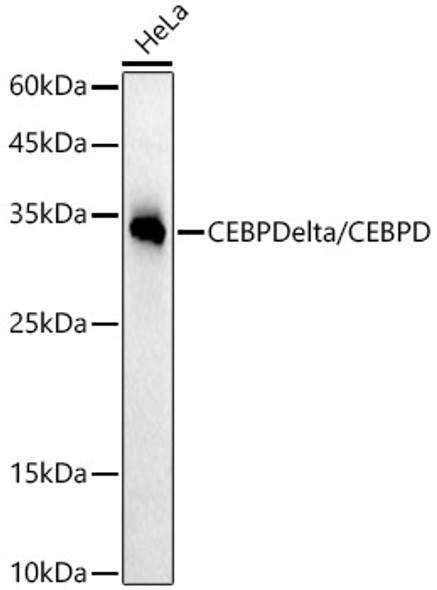Metabolism Antibodies 1
Anti-EBP Antibody (CAB14845)
- SKU:
- CAB14845
- Product Type:
- Antibody
- Reactivity:
- Mouse
- Reactivity:
- Rat
- Host Species:
- Rabbit
- Isotype:
- IgG
- Antibody Type:
- Polyclonal Antibody
- Research Area:
- Metabolism
Description
| Antibody Name: | Anti-EBP Antibody |
| Antibody SKU: | CAB14845 |
| Antibody Size: | 20uL, 50uL, 100uL |
| Application: | WB |
| Reactivity: | Mouse, Rat |
| Host Species: | Rabbit |
| Immunogen: | A synthetic peptide corresponding to a sequence within amino acids 50-150 of human EBP (NP_006570.1). |
| Application: | WB |
| Recommended Dilution: | WB 1:500 - 1:2000 |
| Reactivity: | Mouse, Rat |
| Positive Samples: | Mouse liver, Rat liver |
| Immunogen: | A synthetic peptide corresponding to a sequence within amino acids 50-150 of human EBP (NP_006570.1). |
| Purification Method: | Affinity purification |
| Storage Buffer: | Store at -20'C. Avoid freeze / thaw cycles. Buffer: PBS with 0.02% sodium azide, 50% glycerol, pH7.3. |
| Isotype: | IgG |
| Sequence: | SGRA AVVP LGTW RRLS LCWF AVCG FIHL VIEG WFVL YYED LLGD QAFL SQLW KEYA KGDS RYIL GDNF TVCM ETIT ACLW GPLS LWVV IAFL RQHP LRFI L |
| Gene ID: | 10682 |
| Uniprot: | Q15125 |
| Cellular Location: | Endoplasmic reticulum membrane, Multi-pass membrane protein |
| Calculated MW: | 26kDa |
| Observed MW: | 26kDa |
| Synonyms: | EBP, CDPX2, CHO2, CPX, CPXD, MEND |
| Background: | The protein encoded by this gene is an integral membrane protein of the endoplasmic reticulum. It is a high affinity binding protein for the antiischemic phenylalkylamine Ca2+ antagonist [3H]emopamil and the photoaffinity label [3H]azidopamil. It is similar to sigma receptors and may be a member of a superfamily of high affinity drug-binding proteins in the endoplasmic reticulum of different tissues. This protein shares structural features with bacterial and eukaryontic drug transporting proteins. It has four putative transmembrane segments and contains two conserved glutamate residues which may be involved in the transport of cationic amphiphilics. Another prominent feature of this protein is its high content of aromatic amino acid residues (>23%) in its transmembrane segments. These aromatic amino acid residues have been suggested to be involved in the drug transport by the P-glycoprotein. Mutations in this gene cause Chondrodysplasia punctata 2 (CDPX2; also known as Conradi-Hunermann syndrome). |
| UniProt Protein Function: | EBP: Catalyzes the conversion of Delta(8)-sterols to their corresponding Delta(7)-isomers. Defects in EBP are the cause of chondrodysplasia punctata X-linked dominant type 2 (CDPX2); also known as Conradi-Hunermann-Happle syndrome. CDP is a clinically and genetically heterogeneous disorder characterized by punctiform calcification of the bones. The key clinical features of CDPX2 are chondrodysplasia punctata, linear ichthyosis, cataracts and short stature. CDPX2 is a rare disorder of defective cholesterol biosynthesis, biochemically characterized by an increased amount of 8-dehydrocholesterol and cholest-8(9)-en-3-beta-ol in the plasma and tissues. Belongs to the EBP family. |
| UniProt Protein Details: | Protein type:Membrane protein, multi-pass; Membrane protein, integral; Isomerase; EC 5.3.3.5; Lipid Metabolism - steroid biosynthesis; Endoplasmic reticulum Chromosomal Location of Human Ortholog: Xp11.23-p11.22 Cellular Component: endoplasmic reticulum; endoplasmic reticulum membrane; integral to plasma membrane Molecular Function:drug transporter activity; steroid delta-isomerase activity; transmembrane receptor activity Biological Process: cholesterol biosynthetic process via desmosterol; cholesterol biosynthetic process via lathosterol; cholesterol metabolic process; skeletal development Disease: Chondrodysplasia Punctata 2, X-linked Dominant; Mend Syndrome |
| NCBI Summary: | The protein encoded by this gene is an integral membrane protein of the endoplasmic reticulum. It is a high affinity binding protein for the antiischemic phenylalkylamine Ca2+ antagonist [3H]emopamil and the photoaffinity label [3H]azidopamil. It is similar to sigma receptors and may be a member of a superfamily of high affinity drug-binding proteins in the endoplasmic reticulum of different tissues. This protein shares structural features with bacterial and eukaryontic drug transporting proteins. It has four putative transmembrane segments and contains two conserved glutamate residues which may be involved in the transport of cationic amphiphilics. Another prominent feature of this protein is its high content of aromatic amino acid residues (>23%) in its transmembrane segments. These aromatic amino acid residues have been suggested to be involved in the drug transport by the P-glycoprotein. Mutations in this gene cause Chondrodysplasia punctata 2 (CDPX2; also known as Conradi-Hunermann syndrome). [provided by RefSeq, Jul 2008] |
| UniProt Code: | Q15125 |
| NCBI GenInfo Identifier: | 17374795 |
| NCBI Gene ID: | 10682 |
| NCBI Accession: | Q15125.3 |
| UniProt Secondary Accession: | Q15125,Q6FGL3, Q6IBI9, |
| UniProt Related Accession: | Q15125 |
| Molecular Weight: | 26,353 Da |
| NCBI Full Name: | 3-beta-hydroxysteroid-Delta(8),Delta(7)-isomerase |
| NCBI Synonym Full Names: | emopamil binding protein (sterol isomerase) |
| NCBI Official Symbol: | EBP |
| NCBI Official Synonym Symbols: | CPX; CHO2; CPXD; MEND; CDPX2 |
| NCBI Protein Information: | 3-beta-hydroxysteroid-Delta(8),Delta(7)-isomerase |
| UniProt Protein Name: | 3-beta-hydroxysteroid-Delta(8),Delta(7)-isomerase |
| UniProt Synonym Protein Names: | Cholestenol Delta-isomerase; Delta(8)-Delta(7) sterol isomerase; D8-D7 sterol isomerase; Emopamil-binding protein |
| Protein Family: | Ejaculatory bulb-specific protein |
| UniProt Gene Name: | EBP |
| UniProt Entry Name: | EBP_HUMAN |
View AllClose







